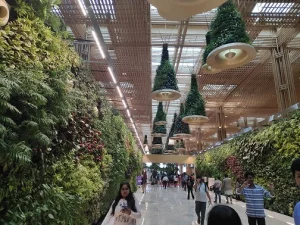 Air Asia India, a Tata group airline based out of Bengaluru is launching its operations from the new Terminal T2 on 15 February.
Air Asia India, a Tata group airline based out of Bengaluru is launching its operations from the new Terminal T2 on 15 February.
Presented as a Terminal in a Garden, T2 at Kempegowda International Airport Ltd (KIAL), Bengaluru is inspired by indigenous craft and traditions and is aesthetically planned to give a rejuvenating experience to passengers, by adopting advanced technology for the eco-friendly design.
Hari Marar, MD and CEO of Kempegowda International Airport Ltd(KIAL), said: “T2 reflects all that the ‘Garden City’ of Bengaluru stands for- green, innovative, modern, sustainable and culturally rich.”
A pleasant experience begins as one walks along the front gardens, mud brick walls and high roof of engineers’ bamboo with big bamboo lanterns.

The new, futuristic, sustainable Terminal 2 at Bengaluru
The bamboo theme continues into the cool terminal where huge hanging bells and veils draw one’s attention. When surprised at live plants adorning the three different sized bells, Shriram Salunkhe, Vice President-Landscaping & Horticulture at GVK Group, KIAL, intervenes to explain that: “The biggest Bell has 2700 live plants, medium one 1800 and the smallest has 900 plants that are strategically positioned on them. These are networked and connected to auto irrigation system that is monitored by Artificial Intelligence(AI) for their light and water requirement.”
Accordingly, the biggest bell requires only 20 litres of water once in 20 days. Daylight is filtered through delicate lattices of bamboo.
All 7700 plants uprooted during the construction are transplanted back at the terminal that accounts for 3600 species of plants, along with 620 endemic and 180 rare and endangered species.
Terminal interiors are clad in engineered bamboo that also works as a fire retardant. Bell-shaped lighting fixtures are crafted out of banana fibre paper. Daylight harvesting panels in the roof ensure enough lighting inside the terminal during the day.
100 percent renewable energy is used across the campus. Rainwater-fed ponds sustain the airport’s water requirement. Solid waste management converts all biodegradable waste into fuel and manure.
The temperature inside the terminal is 2-3 degrees lower than the outside temperature due to its cool features.
The garden experience continues through the departure walkway onto a soothing waterfall and beyond.
With a total of 255,651 sqm built-up area, KIAL’s T2 is the largest terminal in the world to achieve LEED certification by US Green Building Council (USGBC).
T2 also has self-check-in and baggage drop counters where face biometrics work as a boarding pass.
Phase 1 of T2 can handle 25 million passengers per annum (MPPA) and has 90 check-in counters, 22 security check lanes, 36 emigration counters, 60 immigration counters and 9 baggage claim belts.
T2 project also consists of a CAT IIIB-compliant runway, parallel taxiway and India’s first Underpass Tunnel open for vehicular traffic passing underneath an active taxiway. Bengaluru is the home base and largest hub for AirAsia India, which operates 43 daily departures connecting Bengaluru to Delhi, Goa, Mumbai, Hyderabad, Kolkata, Bhubaneswar, Guwahati, Pune, Jaipur, Lucknow, Ranchi, Kochi, Chennai, Visakhapatnam and Surat.
Following Air Asia, other domestic airlines are expected to fly out of T2.
Mr Marar said “By March, we will operationalise all the domestic airlines that will move to T2. We aim to position Bengaluru as the new gateway to India.” International airlines are expected to shift to T2 by early next year. Currently, KIAL has evolved to be a gateway to Southern India.
Written by: Madhura Katti















